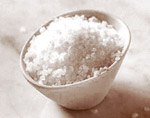 Salt is crucial for our health, but currently we eat, on average, at least two and a half times what we need. Critics say that only some people are sensitive to salt and that these are the people, along with anyone with heart problems, liver disease or kidney disease, who need to watch their salt intake. So, is salt a friend or a foe for us?
Salt is crucial for our health, but currently we eat, on average, at least two and a half times what we need. Critics say that only some people are sensitive to salt and that these are the people, along with anyone with heart problems, liver disease or kidney disease, who need to watch their salt intake. So, is salt a friend or a foe for us?
Salt in the news
Salt is back in the headlines. In March 2006 the Food Standards Agency published new (voluntary) salt reduction targets for food manufacturers and retailers to reduce salt levels by 2010. Overconsumption of salt is linked to high blood pressure, heart disease and stroke.
The FSA's aim is to encourage the reduction of salt levels in 85 food categories that contribute most to the amount of salt in diets of UK consumers. These include: bread, breakfast cereals, cheese, ready-meals, cakes, biscuits , pastries, bacon and other foods. However, some campaigners argue that the voluntary targets don't go far enough, possibly endangering the lives of thousands of at-risk people. Food manufacturers, represented by the Food and Drink Federation, on the other hand, believe the new the targets present a challenge to the industry.
How much salt should we eat?
Salt is crucial for our health, but currently we eat, on average, at least two and a half times what we need. The Government is trying to reduce average salt consumption for adults from more than 9g a day to no more than 6g. They think levels should be even lower for babies and children, recommending less than 1g per day from 0-6 month; 1g per day from 7-12 months; 2g per day from 1-3 years; 3g per day from 4-6 years; and 5g per day from 7-10 years. These are maximum levels, and they advise parents to aim for less.
Where is the salt in our food?
Six grams of salt is a level teaspoonful. It's difficult to measure consumption because 65-85% of our salt is already in the foods we eat, and not what we add in cooking and at the table. Bread, breakfast cereals, biscuits, baked beans and ready-meals can be high in salt, alongside more obviously salty-tasting foods such as crisps, bacon, cheese and olives.
Adding it up
Food labels can be confusing. To find out how much salt is in an item, you need to check the label for sodium, which is the component of salt (sodium chloride) associated with health risks. As a guide, 0.5g or more of sodium per 100g is a high level, below 0.5g is moderate and 0.1g is low. To get the amount of salt by weight, multiply the sodium content by 2.5. Then you need to make sure you work out what you are eating per serving (a guideline portion may be given on the label). A salty anchovy can go a long way in a bowl of spaghetti, while you can consume a large amount of unnoticed sodium in a curry ready-meal.
Is salt bad for all of us?
Some scientists and food writers believe that salt has been demonised without conclusive evidence. They point out that Intersalt, a significant 1988 global study on salt consumption and high blood pressure, with more than 10,000 participants, did not prove a link between high blood pressure and salt consumption in healthy people, though it did show the more salt consumed, the more likely it was that blood pressure could increase with age.
Critics argue that only some people are sensitive to salt and that these are the people, along with anyone with heart problems, liver disease or kidney disease, who need to watch their salt intake. For everyone else, argues food writer Jeffrey Steingarten, the food writer for American Vogue magazine, in an essay in ‘The Man Who Ate Everything' (Headline), salt is an important part of good food.
Such ideas are disputed by health bodies who argue there is a clear health risk in eating salt, not just for blood pressure but also because of links to osteoporosis, stomach cancer and other health problems. Since it is difficult to measure salt sensitivity and much of the salt in our diet is unnecessary, they say the best advice is to cut down and save lives. In Britain, many food manufacturers have agreed to gradually lower salt levels in processed foods.
Advice for healthy living
Both those who agree and disagree with the connection between high blood pressure and salt say that eating plenty of vegetables, fruits and seeds alongside taking exercise, not becoming overweight and not drinking too much alcohol, are other factors important in preventing high blood pressure. Replacing salty processed foods with fresh foods is likely to be beneficial for reasons other than just salt. It is overall diet and lifestyle that matter, not just one component.

